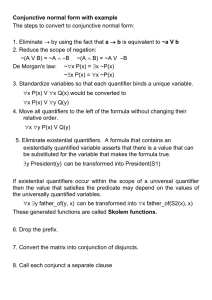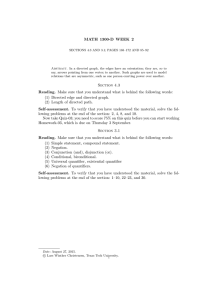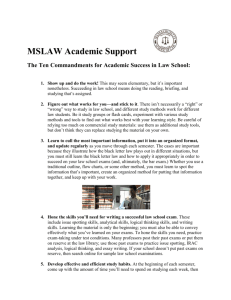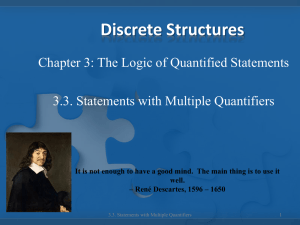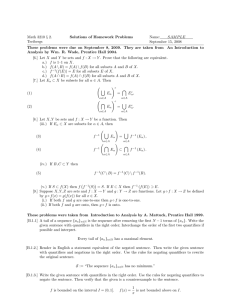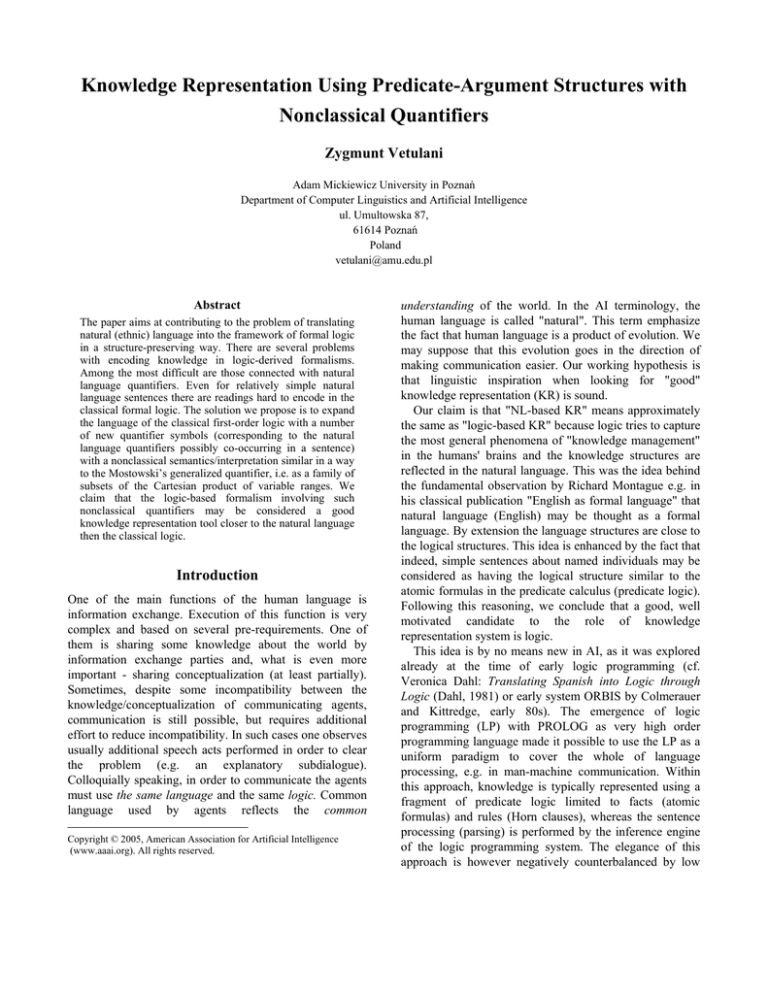
Knowledge Representation Using Predicate-Argument Structures with
Nonclassical Quantifiers
Zygmunt Vetulani
Adam Mickiewicz University in Poznań
Department of Computer Linguistics and Artificial Intelligence
ul. Umultowska 87,
61614 Poznań
Poland
vetulani@amu.edu.pl
Abstract
The paper aims at contributing to the problem of translating
natural (ethnic) language into the framework of formal logic
in a structure-preserving way. There are several problems
with encoding knowledge in logic-derived formalisms.
Among the most difficult are those connected with natural
language quantifiers. Even for relatively simple natural
language sentences there are readings hard to encode in the
classical formal logic. The solution we propose is to expand
the language of the classical first-order logic with a number
of new quantifier symbols (corresponding to the natural
language quantifiers possibly co-occurring in a sentence)
with a nonclassical semantics/interpretation similar in a way
to the Mostowski’s generalized quantifier, i.e. as a family of
subsets of the Cartesian product of variable ranges. We
claim that the logic-based formalism involving such
nonclassical quantifiers may be considered a good
knowledge representation tool closer to the natural language
then the classical logic.
Introduction
One of the main functions of the human language is
information exchange. Execution of this function is very
complex and based on several pre-requirements. One of
them is sharing some knowledge about the world by
information exchange parties and, what is even more
important - sharing conceptualization (at least partially).
Sometimes, despite some incompatibility between the
knowledge/conceptualization of communicating agents,
communication is still possible, but requires additional
effort to reduce incompatibility. In such cases one observes
usually additional speech acts performed in order to clear
the problem (e.g. an explanatory subdialogue).
Colloquially speaking, in order to communicate the agents
must use the same language and the same logic. Common
language used by agents reflects the common
Copyright © 2005, American Association for Artificial Intelligence
(www.aaai.org). All rights reserved.
understanding of the world. In the AI terminology, the
human language is called "natural". This term emphasize
the fact that human language is a product of evolution. We
may suppose that this evolution goes in the direction of
making communication easier. Our working hypothesis is
that linguistic inspiration when looking for "good"
knowledge representation (KR) is sound.
Our claim is that "NL-based KR" means approximately
the same as "logic-based KR" because logic tries to capture
the most general phenomena of "knowledge management"
in the humans' brains and the knowledge structures are
reflected in the natural language. This was the idea behind
the fundamental observation by Richard Montague e.g. in
his classical publication "English as formal language" that
natural language (English) may be thought as a formal
language. By extension the language structures are close to
the logical structures. This idea is enhanced by the fact that
indeed, simple sentences about named individuals may be
considered as having the logical structure similar to the
atomic formulas in the predicate calculus (predicate logic).
Following this reasoning, we conclude that a good, well
motivated candidate to the role of knowledge
representation system is logic.
This idea is by no means new in AI, as it was explored
already at the time of early logic programming (cf.
Veronica Dahl: Translating Spanish into Logic through
Logic (Dahl, 1981) or early system ORBIS by Colmerauer
and Kittredge, early 80s). The emergence of logic
programming (LP) with PROLOG as very high order
programming language made it possible to use the LP as a
uniform paradigm to cover the whole of language
processing, e.g. in man-machine communication. Within
this approach, knowledge is typically represented using a
fragment of predicate logic limited to facts (atomic
formulas) and rules (Horn clauses), whereas the sentence
processing (parsing) is performed by the inference engine
of the logic programming system. The elegance of this
approach is however negatively counterbalanced by low
efficiency of the standard processing techniques
(combinatorial explosion)1 and the limited expressiveness
of the so limited logic. It is to notice here that even the full
classical logic (e.g. the classical predicate calculus or any
equivalent) does not provide a satisfactory solution in what
concerns expressiveness. Indeed, every student of
mathematics knows how awkward are sometimes
mathematical statements when translated into logic. This is
so because the classical formal logic is intentionally poor
in formal devices (as e.g. quantifiers) in order to make
relatively simple its inference system.
Problems with quantifiers
One of the major problems, well identified since long time
ago, is how to formally represent knowledge expressed in
natural language with NL quantifiers. It is to notice here
that already Andrzej Mostowski in (Mostowski, 1957)
extended the Tarski's semantics in a way to make possible
interpretation of various nonstandard quantifiers (covered
by a generic term generalized quantifier). This
contribution was a side effect of Mostowski's works in
metamathematics and has remained practically unexplored
until early 80-ties. At that time Barwise and Cooper
published their very influential paper on Generalized
quantifiers and natural language (Barwise & Cooper,
1981) where NL-quantifiers and their mathematical
properties were systematically studied on the ground of
Mostowski's earlier works. (By NL-quantifier we mean,
after Barwise and Cooper, expressions used in natural
language to represent quantitative aspects of relationships.)
These may be traditional quantifiers (every, some...),
numerals (one, two,...), articles and other (many,...). One
of the most important results due to Barwise and Cooper is
the proof that some of NL-quantifiers may not be defined
on the ground of classical logic. We may conclude from
this observation that if we wish the logic-based knowledge
representation system to be possibly close to natural
language, then we should consider such undefinable
quantifiers and define their formal semantics. The
existence of undefinable quantifiers may be considered
surprising because we have tendency to believe that logic
is a common and universal background to all knowledge.
In fact, the traditional formal logic (e.g. in form of
predicate calculus) was created in order to formalize
mathematics in the form of a formal axiomatic system (as
it was described e.g. in Principia Mathematica). For this
purpose considering the two classical quantifiers was
enough.
1
Our works on question answering (system POLINT
implemented for the Polish language) show how to cope with this
problem (successfully) (Vetulani, 2002).
Unfortunately, extending logic by introduction of "new"
quantifiers and giving them semantics following the ideas
of Mostowski, Barwise and Cooper does not solve all
problems connected with quantifiers. Below, we will focus
on the case of ambiguous sentences in which co-existence
of different NL-quantifiers allows several readings, where
some these readings can not be expressed in logic, even
extended by the respective quantifiers. As example we will
consider the sentence already investigated by several
authors (Kempson, Cormarck, Bellert):
(S)
Two professors marked six exams.
Considering "two" and "six" as quantifiers causes
problems when trying to extend the traditional
interpretation to cover all possible readings practiced by
humans. The reading that makes trouble may be
graphically represented as follows:
two professors
six exams
Reading 1
In Reading 1, both NL-quantifiers ("two" and "six") are
used in the "+absolute" way, i.e. there exist exactly two
professors and exactly six exams involved in the situation.
(Cf. below in the section “Context/reading parameter”.)
This reading leaves open the problem what links between
professors and exams are referred to by the predicative
word "marked" (which professor is "connected" with
which exam). We say that within this reading both NLquantifiers considered are "-distributive" one with respect
to the other.
The remaining readings may be grouped into three
classes as illustrated by the corresponding figures.
two professors
six exams
Reading 2
In Reading 2 both NL-quantifiers ("two" and "six") are
used in the "+absolute" way (as in Reading 1), but are
respectively "+distributive". The relation distributes in the
"each-to-each" way. The remaining two readings
corresponds to situations where only one of quantifiers is
used in the "+absolute" way.
two professors
six exams
where ║Q║ is a family of (some) subsets of the universe
U of the structure M.2 Clearly, the Reading 1 can not be
captured under the assumption of the above mentioned
scope dependency.
The family of sets ║Q║ is considered as the
"interpretation" (or "meaning") of the NL-quantifier Q
with respect to M. (The interpretation of the quantifier
"two" will be the family of all two-element subsets of U.)
It is clear that Tarskis's semantics extended in this way
covers only the last three readings of our example.
The solution proposed
The solution we propose consists in considering the whole
configuration of NL-quantifiers as a single (although
complex) one (i.e. as a kind of single generalized
quantifier).
Reading 3
Nonclassical quantifiers
In Reading 3 each element form the domain of the
"+absolute" quantifier is connected with exactly six
elements of the other domain (we say that "two" is
+distributive with respect to "six") but this does not go in
the other direction (in this reading "six" is "-distributive"
with respect to "two"). (Formaly "six" is in the scope of
"two".) The following scheme presents the symmetrical
situation of Reading 4.
six exams
two professors
We propose to represent simple NL sentences involving
several quantifiers as composed of a predicate-argument
structure and a configuration of quantifiers3 corresponding
to the argument positions. We propose the following
notation:
(Q1x1,Q2x2,...,Qnxn) P(x1,x2,...,xn)
where (Q1x1,Q2x2,...,Qnxn) will be called nonclassical
quantifier.
In the case we investigated above the corresponding
formula is:
(Two professors, Six exams) marked(professors, exams)
Reading 4
Problems with formal representation of the first considered
reading (Reading 1) are due to the fact that application of
the extension of the Tarski’s truth definition proposed by
Mostowski requires one quantifiers to be in the scope of
the other.
The Mostowski truth definition for quantifiers is as
follows:
(*) M╞Qx P(x) iff {x∈U: M╞Qx P(x)} ∈ ║Q║
Contrary to the classical definition (*) provided above, the
semantics of this complex quantifier will be defined for
particular reading depending of the context. By context we
mean this factor which differentiates readings. The nature
of this factor is (usually) pragmatic, but sometimes the
reading may also be indicated by formal features, as e.g.
word order.
In the following, the context will be represented by the
parameter C (we will say contex/reading parameter). As in
Mostowski’s truth condition in (*), the interpretation
║(Q1x1,Q2x2,...,Qnxn)║C will be some family of subsets of
the universe and more precisely a family of subsets of the
cartesian product │U1│×│U2│×... ×│Un│of domains
corresponding to arguments, i.e.
2
The Tarski’s truth relation ╞ is relativised to some relational
structure M. In order to simplify notation, further in this text we
will omit the reference to M; ║Q║ is also called Mostowskian
quantifier.
3
The concept of configuration of quantifiers was discussed
already in (Vetulani, 1987).
║(Q1x1,Q2x2,...,Qnxn) ║C ⊂ P(│U1 │×│U2 │×... ×│Un│)
The definition is as follows:
╞C (Q1x1,...,Qnxn) P(x1,...,xn) iff
{(x1,...,xn):╞C P(x1,...,xn)}∈║(Q1x1,...,Qnxn) ║C, xi∈│Ui│}
Now, what remains to do is to define the interpretations
║Q║C for each configuration of quantifiers Q and each
context (reading) C.
Let us remark that the formula (Q1x1,Q2x2,...,Qnxn)
P(x1,x2,...,xn), makes abstraction of the surface linear
ordering of quantifiers in the sentence and also of the
scope dependencies between quantifiers reflected in the
traditional notation. This effect is intended as in many free
word order languages (e.g. Slavonic languages, Latin) the
surface succession of quantifiers do not necessarily
correspond to the scope relations marked rather by
inflection cases. Consistently, we prefer to consider this
information as a part of context/reading parameter. This
means that the predicate logic formulas (∀x(∃yP(x,y)) and
(∃y(∀xP(x,y)) are both represented by one and the same
formula (∀x,∃y) P(x,y) and the scope relationship between
∀ and ∃ is to be encoded by the context/reading parameter.
The interpretation ║(∀x,∃y)║C1 for C1 corresponding to
the classical reading of the formula (∀x(∃yP(x,y)) is as
follows:
║(∀x,∃y)║C1 = {R ⊂ │x│×│y│: Dom(R) =│x│}
For C2 corresponding
interpretation is different:
to
(∃y(∀xP(x,y))
the
║(∀x,∃y)║C2 =
{R⊂│x│×│y│:Dom(R)=│x│∧ ∩{{y: R(x,y)}:x∈X} ≠∅}
For the sentence Two professors marked six exams
considered in the context C corresponding to the Reading 2
in the case where professors and exams are unambiguously
identified as respectively p1, p2 and e1,...,e6 , we obtain the
following interpretation:
║(Two professors, Six exams)║C =
{{(pi, ej): i=1,2, j=1,...,6}}
Let C’ be the context corresponding to the Reading 2 but
without the assumption that the involved entities are
identified. In this case the interpretation is more complex
and consists of a family of sets, each composed of 12
ordered pairs (linking exams to professors).
We leave the illustration of the remaining reading as an
exercise for the Reader.
It follows from the above definitions and the examples
that truth conditions for a given reading of a sentence with
n quantifiers may be articulated as properties of some n-ary
relation.
Context/reading parameter
From both the practical and theoretical points of view the
question concerning the nature of the context/reading
parameter is of fundamental importance. In this chapter we
consider what kind of information should be encoded in
the context/reading parameter and how this information
may be represented.
One of possible answers to this problems may be
derived from Bellert’s monograph on NL quantifiers
(Bellert, 1989). Among various issues addressed there, the
one about possible readings of the NL-quantifiers cooccurring in the sentence is of special interest for us. The
author formulates
and discusses the idea of
characterization of all possible readings in terms of the two
features associated to NL-quantifiers in the sentence.
These are +/- absoluteness and +/- distributiveness face to
the co-occurring NL-quantifiers. Informally, “the value
plus of absoluteness indicates that a given N″ may
represent exactly one reference class in any particular
context of use (e.g. as in the case of ‘these girls’)”,
similarly “the value minus of absoluteness indicates that
the N″ in question may represent more then one reference
class”.4 The value plus of distributiveness of a quantifier
with respect to a co-occurring quantifier indicates that the
relation expressed by the predicate is distributed among the
all members of some reference class of this co-occurring
quantifier (or the reference class if this co-occurring
quantifier appears to be +absolute). Minus of
distributiveness indicates that the relation is “is distributed
among some, not necessarily all, members of the reference
classes of the corresponding N″ (as in “Five students were
sitting in these two rooms”)”.5 In our example
(S)
The Reading 1 is characterized by the feature values
attributed as follows:
“two professors”:
+absolute
-distributive with respect to “six exams”
“six exams”:
4
║(Two professors, Six exams)║C’ =
{{(xi, yj): i=1,2, j=1,...,6}: x1,≠x2}, ym=yn → m=n,
for m,n=1,2,…,6, where xi are professors, yj are exams}
Two professors marked six exams.
In Chomsky’s X-bar notation N″ stands for “full noun phrase”.
Although formally similar to our example “Two professors
marked six exams”, the sentence “Five students were sitting in
these two rooms” has only one reading, the other being excluded
by the selection of the lexical material.
5
+absolute
-distributive with respect to “two professors”,
whereas the Reading 3 by:
“two professors”:
+absolute
+distributive with respect to “six exams”
“six exams”:
-absolute
-distributive with respect to “two professors”
The main observation of the Bellert’s monograph we refer
to is that not all of the possible combinations of feature
values are linguistically admissible. The rules are proposed
in application to pairwise co-occurring quantifiers in order
to determine the linguistically admissible readings of
quantifiers.6 Thus the configurations of feature values as
admitted by these rules may be considered as candidates
for context/reading parameters to be used in the definition
of semantics for the nonclassical quantifier as provided
above.
Remark. The complexity of the problem we try to
manage in this paper (i.e. problems of interpretation of
sentences with many quantifiers) may be illustrated by the
example communicated to us by the Anonymous Reviewer
of this paper who objected that our approach does not
capture the case where “Professor A graded all 6 of
Problem 1’s and Professor B graded all 6 of the
Problem 2’s”. A possible answer is that the sentence (S)
with such an intended meaning is not about exams, but
about <exam, problem> pairs, and therefore the Reading 3
perfectly applies in this case.
Another solution?
The representation problems discussed in Chapter 2 may
also find solution on the ground of higher order logic, i.e.
logic allowing higher order quantifiers. Let us then try to
describe readings with the help of second order NLquantifiers "The Two" and "The Six" applied respectively
to professors and to exams.
On this ground the particular readings of the sentence
Two professors marked six exams
may be characterized by the corresponding second order
formulas as follows:
6
Three such rules were proposed:
(absoluteness) If Qi is –absolute then there is an +absolute cooccuring quantifier Qk such that Qk is + distributive with respect
to Qi and Qi is -distributive with respect to Qk.
(weak-symmetry) If If Qk is +absolute and Qi is +distributive
with respect to Qk,, then Qi is +distributive with respect to Qi.
(transitivity) If Qi is -distributive with respect to Qk and Qk is distributive with respect to Qm, then Qi is -distributive with
respect to Qm.
•
READING 1
For each X of The Two professors,
There exists Some Y
among The Six exams that:
marked(X,Y)
and
For each Y of The Six exams,
There exists Some X
among The Two professors that: marked(X,Y)
•
READING 2
For each X of The Two professors
and
For each Y of The Six exams: marked(X,Y)
•
READING 3
For each X of The Two professors,
There exists The Six exams
and
There exists Y among The Six exams
that: marked(X,Y)
•
READING 4
For each Y of The Six exams,
There exists The Two professors
and
There exists X among The Two professors
that: marked(X,Y)
Final remarks
From the two solutions presented in this paper we claim
that the first one better satisfies the postulate to maintain a
possibly close formal relationship between the Natural
Language structures and the corresponding formal
Knowledge Representation structures. Although the other
solution presented above seems simple and elegant, it has a
serious drawback as it requires involvement of the very
strong second order formalism which is computationally
inconvenient. In any case further investigation is necessary
to evaluate the computational aspects of the proposed
solutions. Another class of problems that appear as a result
of the introduction of the nonclassical quantifier as defined
above concerns the mathematical properties of logic
systems
allowing
such
quantifiers
(possible
axiomatisations and their properties: completeness,
compactness, Löwenheim property,…). Another problem
of interest is how frequently the proposed techniques may
appear necessary in practical considerations. We intend to
tackle this problem in the future.
Acknowledgements
Thanks are due to Irena Bellert whose enthusiasm for
quantifier related issues helped me to better understand the
importance of quantifier studies. The Author wishes to
thank the four Anonymous Reviewers for constructive
remarks which encouraged him to continue working on the
problems presented in this paper.
References
Barwise, J., and Cooper, R. 1981. Generalized Quantifiers
and Natural Language. Linguistic and Philosophy 4: 159–
219.
Bellert, I. 1989. Feature System for Quantification
Structures in Natural Language. Dordrecht-Holland /
Providence RI-USA: Foris Publications.
Dahl, V. 1981. Translating Spanish into logic through
logic. Computational Linguistic. Volume 7, Issue 3: 149–
164.
Mostowski, A. 1957. On a Generalization of Quantifiers.
Fundamenta Mathematicae 44: 12-36.
Vetulani, Z.
1987.
On
Bellert's
approach
to
quantificational universals. Studia Logica XLVI, 4: 311–
320.
Vetulani, Z. 2002. Question Answering system for Polish
(POLINT) and its language resources. In: M. Maybury
(ed.). Proceedings of the Workshop on Question
Answering: Strategy and Resources, LREC 2002. 51–55.
Paris: ELRA.

